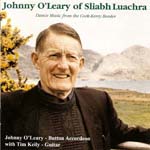folk icons
Johnny O’Leary of Slíabh Luachra
![]()
Jerry with Ellen Healy and Johnny O’Leary
Johnny O’Leary was born in 1924 in Maulykeavane which is about half-way between Killarney and Ballydesmond, in the centre of Slíabh Luachra. He lived in the area all his life, and spent his whole life learning and playing the local music.
It is an area that has surely produced more musicians for its size and population than any other part of Ireland. Johnny played with them all, learning tunes and passing on tunes and creating with his fellow musicians an unequalled tradition of music-making.
He started picking out tunes on the melodeon at the age of five and by his early teens he was regularly playing for local dances.
By the time he was 15 he had struck up a musical partnership with Denis Murphy that was to last a remarkable 37 years, ending only with Denis’s death.
In 1964 Johnny and Denis accepted an invitation to play in Dan O’Connell’s newly opened pub in Knocknagree, and Johnny played for the sets there, every Friday and Sunday night until his illness and death in 2004.
Johnny O’Leary band
plays for Cork set dancers of Knocknagree pub (1977)
Johnny O’Leary : accordion
Eileen O’Leary : whistle
Michael Duggan : fiddle
Kathleen OKeeffe : whistle, Kerry slides : The Hare in the Corn.
The great scholar of Irish traditional music Breandán Breathnach, had for many years been visiting Slíabh Luachra and collecting music from Johnny.
He intended to publish this material because he regarded Johnny’s playing as preserving the style and repertoire of the area and of its famous musicians Padraig O’Keeffe, Denis Murphy and Julia Clifford, Tom Billy Murphy, Din Tarrant & Thadelo Sullivan to name only a few.
Breandán’s project was taken over by Terry Moylan after his death in 1985 and was brought to completion in July 1994 when a collection of 348 of Johnny’s tunes was published by the Lilliput Press in Dublin.

Johnny O’Leary’s reels, jigs and hornpipes are generally part of the broader national store of music, but his polkas, slides and barn-dances are often quite unusual and little known. Also, with his style of playing be was able to invest such apparently simple forms with considerable complexity.
They always sounded far more interesting in his hands than in the hands of others.
The Slíabh Luachra musicians seem to be able to get more out of these tunes than musicians from outside that tradition. He could also inject an infectious energy into the music without a crude resort to excessive speed.
He was always regarded by discerning dancers as a joy to dance and listen to.
Terry Moylan
Brooks Academy
![]()
Folk Leads Publications 2008